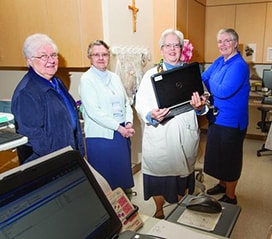
The following article was originally posted in Buffalo Business First by Annemarie Franczyk. View the story here.
Once upon a time, the Daughters of Charity Sisters who worked in Western New York reached into the 800s.
Today their numbers fit around a kitchen table.
There are just four of the Sisters in the region, assigned by their province in St. Louis, Mo., to carry out the community’s mission to serve the poor, primarily in Niagara Falls.
Two of them, Sister Nora Sweeney, a social worker, and Sister Nancy Murphy, a physician assistant, are on staff at Mount St. Mary’s Neighborhood Health Center. The clinic is on Ninth Street off Highland Avenue, an area of public housing, industry and empty lots. A street-side memorial to a shooting victim recently grew in front of a neighborhood bar where the crime occurred.
Two minutes away, their colleague, Sister Mary Kay Tyrell, a retired nurse-midwife, is community care coordinator of the Heart, Love & Soul food pantry and dining program. It serves more than 200 meals daily.
And at Mount St. Mary’s Hospital in Lewiston, Sister Grace Marie Dunn works with the administration as vice president for mission integration. The hospital is in the process of affiliating with Buffalo-based Catholic Health.
The Sisters, small in number but instrumental, help the hospital stay focused on the poor and vulnerable, said hospital President and CEO Judith Maness.
“They challenge us and inspire us to be a part of the larger community of those who are able and willing to stand with those who are less fortunate,” Maness said. “They ask us to love the persons who are poor just as they do, for the lessons they can teach us. And those lessons include that it’s the hand up more than the hand out that is important.”
The Sisters became the only four of their community in the region when the five working at Sisters of Charity Hospital in Buffalo were reassigned out of the area last summer.
The decision was part of the plan created when, faced with lagging membership, four provinces merged in 2011 and formed the Daughters of Charity Province of St. Louise.
They pooled their resources and withdrew from 10 dioceses or programs within dioceses to marshal their efforts in areas of greatest need.
Revision, regrouping and handing off the mission isn’t unprecedented for the 400-year-old community, Dunn said.
“We turn things over to Catholic laypeople, respectful of their abilities to serve the poor. I think a nonreligious person, if they are a faithful person, can do this,” she said. “We don’t just leave until we know we have people who understand the mission. We know they will keep the mission going.”
Dwindling numbers are not unique to the Daughters of Charity. The number of nuns in the United States has fallen 72 percent, from a high of 179,000 five decades ago to 49,000 last year, according to the Center for Applied Research in the Apostolate at Georgetown University.
At the same time, the population of nuns in the Catholic Diocese of Buffalo fell 78 percent, from 3,592 to 790, according to diocesan statistics.
The Daughters of Charity community has continued to lose members since the reorganization. Sixty-five have died since 2011, trimming the national membership to 475.
But leaders are encouraged by the 20 or so women who are in various stages of joining the order, said Belinda Davis, director of communication for the province.
Like senior staff in any other industry, the four–with between 22 and 60 years of service as Sisters–are role models to other employees and volunteers.
They help provide the holistic approach taken to patient care, said Patricia Villani, health center director.
She recalled a time, for example, when Sweeney, “working the room” as she does when patients are waiting for their doctor’s appointment, found a widow with children who was denied Social Security survivor benefits.
It had been 10 years since her husband died and she nearly gave up trying.
When Sweeney, the social worker with a never-say-no attitude, took control, the woman received benefits and back pay, as well, Villani said.
“The nuns lead by example,” she said. “They go above and beyond what happens in a clinic like this. They’re adding the extra touch.”
